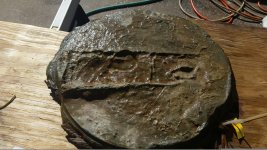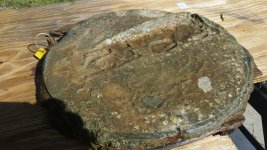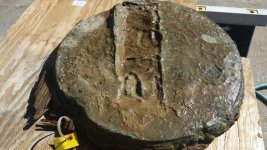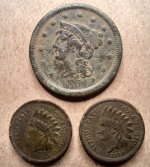- Jun 3, 2007
- 1,188
- 1,994
- Detector(s) used
- A sharp eye, an AquaPulse and a finely tuned shrimp fork.
- Primary Interest:
- Shipwrecks
OK...found on the Cabin Wreck site....in an undisclosed area, of course.
We have our guess...which I will put at the bottom, below the pictures.
This artifact is lead on at least one side with a similar metal on the opposite side.
I haven't had it analyzed by the pawn shop spectrometer, but I will.
It weighs about 20 lbs.
Sandwiched in between the metal outer layers is thin wood lath...2 layers laid at 90 degrees to each other.
It is obviously round and has evidence that it was part of a barrel.
I will have close-up pics tomorrow.
I have not seen anything like this, but I am a fairly new kid on the block.
What do you folks think?
( In Google Chrome, you can right click...open image in a new tab...click on the new tab and then CTRL-scroll to zoom in)
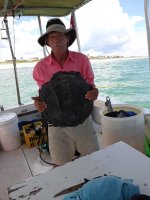
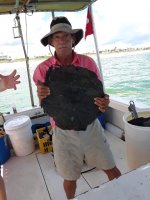
and now...for our guess, which was in agreement with Rex Stocker's assessment of the pictures.
We think this is an intact end of a powder barrel.
(I think it's the top)
Rex said they had found pieces of powder barrels, but not anything this intact.
We are happy to have saved it from the perils of the ocean.
We have our guess...which I will put at the bottom, below the pictures.
This artifact is lead on at least one side with a similar metal on the opposite side.
I haven't had it analyzed by the pawn shop spectrometer, but I will.
It weighs about 20 lbs.
Sandwiched in between the metal outer layers is thin wood lath...2 layers laid at 90 degrees to each other.
It is obviously round and has evidence that it was part of a barrel.
I will have close-up pics tomorrow.
I have not seen anything like this, but I am a fairly new kid on the block.
What do you folks think?
( In Google Chrome, you can right click...open image in a new tab...click on the new tab and then CTRL-scroll to zoom in)


and now...for our guess, which was in agreement with Rex Stocker's assessment of the pictures.
We think this is an intact end of a powder barrel.
(I think it's the top)
Rex said they had found pieces of powder barrels, but not anything this intact.
We are happy to have saved it from the perils of the ocean.
Last edited:




